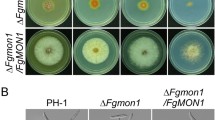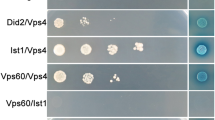Abstract
Oomycete pathogens, such as Phytophthora sojae, encode several hundreds of RXLR effectors to manipulate host immunity responses. For these effectors transporting into the host cells, P. sojae may produce PtdIns(3)P to bind the effectors. Transgenic P. sojae that expressed PtdIns(3)P-specific fluorescent probes were used for PtdIns(3)P distribution in parasite. Fluorescence was associated mainly with the endoplasmic reticulum (ER), where effectors might to bind PtdIns(3)P for transport. Furthermore, PtdIns(3)P biosensor was detected that enriched in haustoria during infection. We also identified three PsPI3Ks functionally complement yeast VPS34, which generates only PtdIns(3)P. These results further demonstrated that P. sojae might generated PtdIns(3)P to benefit their infectious process.





Similar content being viewed by others
References
Altschul S, Gish W, Miller W, Myers E, Lipman D (1990) Basic local alignment search tool. J Mol Biol 215:403–410
Backer JM (2008) The regulation and function of Class III PI3Ks: Novel roles for Vps34. Biochem J 410:1–17
Bhattacharjee S, Hiller N, Liolios K, Win J, Kanneganti T, Young C, Kamoun S and Haldar K (2006) The malarial host-targeting signal is conserved in the Irish potato famine pathogen. Plos Pathogens 2, e50
Bhattacharjee S, Stahelin R, Speicher K, Speicher D, Haldar K (2012) Endoplasmic Reticulum PI(3)P Lipid Binding Targets Malaria Proteins to the Host Cell. Cell 148:201–212
Bozkurt T, Schornack S, Banfield M, Kamoun S (2012) Oomycetes, effectors, and all that jazz. Curr Opin Plant Biol 15:483–492
Dou D, Kale S, Wang X, Jiang R, Bruce N, Arredondo F, Zhang X, Tyler B (2008) RXLR-mediated entry of Phytophthora sojae effector Avr1b into soybean cells does not require pathogen-encoded machinery. Plant Cell 20:1930–1947
Erwin D, Ribeiro O (1996) Phytophthora diseases worldwide. APS Press, St. Paul Minn
Falasca M, Maffucci T (2009) Rethinking phosphatidylinositol 3-monophosphate. Biochim Biophys Acta 1793:1795–1803
Feng Z, Chen X, Bao Y, Dong J, Zhang Z, Tao X (2013) Nucleocapsid of Tomato spotted wilt tospovirus forms mobile particles that traffic on an actin/endoplasmic reticulum network driven by myosin XI-K. New Phytol 200:1212–1224
Gillooly D, Morrow I, Lindsay M, Gould R, Bryant N, Gaullier J, Parton R, Stenmark H (2000) Localization of phosphatidylinositol 3-phosphate in yeast and mammalian cells. EMBO J 19:4577–4588
Hahn M, Mendgen K (2001) Signal and nutrient exchange at biotrophic plant-fungus interfaces. Curr Opin Plant Biol 4:322–327
Helliwell E, Vega-Arreguin J, Shi Z, Bailey B, Xiao S, Maximova S, Tyler B, and Guiltinan M (2015) Enhanced resistance in Theobroma cacao against oomycete and fungal pathogens by secretion of phosphatidylinositol-3-phosphate-binding proteins. Plant Biotechnol J
Herman P, Emr S (1990) Characterization of VPS34, a gene required for vacuolar protein sorting and vacuole segregation in Saccharomyces cerevisiae. Mol Cell Biol 10:6742–6754
Kale S, Gu B, Capelluto D, Dou D, Feldman E, Rumore A, Arredondo F, Hanlon R, et al. (2010) External Lipid PI3P Mediates Entry of Eukaryotic Pathogen Effectors into Plant and Animal Host Cells. Cell 142:284–295
Lee Y (2008) Roles of phosphoinositides in regulation of stomatal movements. Plant Signal Behav 3:211–213
Lu S, Chen L, Tao K, Sun N, Wu Y, Lu X, Wang Y, Dou D (2013) Intracellular and extracellular phosphatidylinositol 3-phosphate produced by Phytophthora species is important for infection. Mol Plant 6:1592–1604
Meijer H, Govers F (2006) Genomewide analysis of phospholipid signaling genes in Phytophthora spp.: Novelties and a missing link. Mol Plant-Microbe Interact 19:1337–1347
Odorizzi G, Babst M, Emr S (2000) Phosphoinositide signaling and the regulation of membrane trafficking in yeast. Trends Biochem Sci 25:229–235
Simon M, Platre M, Assil S, van Wijk R, Chen W, Chory J, Dreux M, Munnik T, et al. (2014) A multi-colour/multi-affinity marker set to visualize phosphoinositide dynamics in Arabidopsis. Plant J 77:322–337
Tamura K, Dudley J, Nei M, Kumar S (2007) MEGA4: Molecular Evolutionary Genetics Analysis (MEGA) software version 4.0. Mol Biol Evol 24:1596–1599
Tyler BM (2009) Entering and breaking: Virulence effector proteins of oomycete plant pathogens. Cell Microbiol 11:13–20
Vanhaesebroeck B, Leevers S, Panayotou G, Waterfield M (1997) Phosphoinositide 3-kinases: a conserved family of signal transducers. Trends Biochem Sci 22:267–272
Vermeer J, van Leeuwen W, Tobena-Santamaria R, Laxalt A, Jones D, Divecha N, Gadella T, Munnik T (2006) Visualization of PtdIns3P dynamics in living plant cells. Plant J 47:687–700
Whisson S, Boevink P, Moleleki L, Avrova A, Morales J, Gilroy E, Armstrong M, Grouffaud S, et al. (2007) A translocation signal for delivery of oomycete effector proteins into host plant cells. Nature 450:115–118
Yaeno T, Li H, Chaparro-Garcia A, Schornack S, Koshiba S, Watanabe S, Kigawa T, Kamoun S, et al. (2011) Phosphatidylinositol monophosphate-binding interface in the oomycete RXLR effector AVR3a is required for its stability in host cells to modulate plant immunity. Proc Natl Acad Sci U S A 108:14682–14687
Acknowledgments
This project is supported by grants from the Special Fund for Agro-scientific Research in the Public Interest (No.201503112).
Author information
Authors and Affiliations
Corresponding author
Electronic Supplementary Material
Table S1
Oligonucleotides used in the study. (DOC 40 kb)
Rights and permissions
About this article
Cite this article
Chen, L., Wang, W., Hou, Y. et al. Phosphatidylinositol 3-phosphate, an essential lipid in Phytophthora sojae, enriches in the haustoria during infection. Australasian Plant Pathol. 45, 435–441 (2016). https://doi.org/10.1007/s13313-016-0430-7
Received:
Accepted:
Published:
Issue Date:
DOI: https://doi.org/10.1007/s13313-016-0430-7




